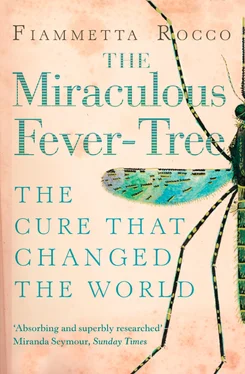Nowhere in Europe was the scourge more deadly, and the need for a cure more acute, than around the Basilica of St Peter’s in the centre of Rome, where every summer for centuries it killed hundreds of people, making no distinction between peasant, priest or pope.
2 The Tree Required – Rome
‘When unable to defend herself by the sword,Rome could defend herself by means of the fever.’
GODFREY OF VITERBO, poet, 1167
Giacinto Gigli lived for sixty-five years in an alleyway by the Via delle Botteghe Oscure. His small townhouse was one of several built close together. They clung, like a gaggle of shy children, to the end of one of the crooked passageways that cluttered the centre of Rome, seeming almost to lean into one another when the wind whipped around them during the early days of winter. Gigli was not born there, but from the time when he was twelve years old until just before Christmas 1671, when he died at the age of seventy-seven, he returned every night from his work in the papal palace at the Vatican and climbed the stairs to the study, his favourite room, at the top of the house, where his desk was placed between two tall windows.
One of them looked westwards, over the bend in the Tiber where tradesmen, prelates and visitors would cross the bridge that led towards the Santo Spirito hospital and beyond it to St Peter’s and the palace of the Vatican. From that window Gigli could just see the golden dome of St Peter’s, though often it seemed almost to fade away in the summer haze, when the city became too hot to bear and the Pope’s court moved to the palaces and villas in the coolness of the hills that surround the city. The other window, on the far side of the room, looked north-east towards the Quirinale, the highest of Rome’s seven hills, where the Pope’s own summer palace had been built so that he could escape the unhealthy summer air, and where a gentle breeze blew all day through the shady trees.
The Gigli family was part of Rome’s petite bourgeoisie , though by his death Giacinto’s father had been able to leave his son the property near the Via delle Botteghe Oscure, two other smaller houses in the centre of the city, and a vineyard on the road to Frascati, a considerable inheritance for a modest man. When he was twelve Gigli entered the Collegio Romano, the Jesuit school where he studied grammar, humanities and rhetoric. For a while he studied law in the studio of Angelo Luciano, a well-known Roman advocate, and graduated as a specialist in papal law. By that time his father was dying, and as Giacinto prepared to take his place as the head of the Gigli family, the young man’s thoughts turned to marriage. He had known Virginia Lucci all his life. She was his neighbour’s daughter, and the time had come to ask for her hand.
As he grew older, Gigli began to acquire the status of a man of respect. He was made a rione , representing his parish of Pigna in the committees and on ceremonial occasions that would occasionally bring together the city and the Holy City. Dressed in velvet and bedecked with feathers, he would walk in line before the horsemen that accompanied the papal processions. Later he was made a caporione , before eventually serving twice as the priore , the head of all the caporioni , responsible to the Pope for helping collect taxes and keeping order within the Holy City. These duties gave Gigli an intimate insight into Rome, and particularly the clerical administration that ran it. He became something of an expert on Vatican politics – who was in favour and more importantly who was not, how different cardinals behaved and how they were discussed. ‘All this and more is the lifeblood of the Holy City,’ he would write.
We don’t know what Gigli looked like, for no contemporary likeness of him survives. But we know a great deal else about him: how he lived, how he filled his day, what he did when he fell ill, whom he saw and what he ate. Gigli was meticulous about recording the details of his life in his diary, which survives in the Vatican library, writing something every day, even if only a brief phrase or two. He wrote in Latin, in an elegant slanting hand, taking care to reach the very edge of the page before starting on the next line.
Gigli had acquired the habit of chronicling his daily life before his marriage. In 1614, when he was only nineteen, he even began an autobiography, entitled Vita. He kept this up assiduously for about five years, making minute notes of everything that went on in his household, recording the names of the servants who came and went, what they were paid and what they earned in tips or small gifts, like the woollen socks that were given to the nurse who came to care for his only son. While this might seem unnecessarily fussy to some, these were not bad habits for a diarist to acquire. In addition, he also wrote poetry, long verses about his native city and eulogies of the Popes in rhyming octets.
The papal court was the centre of Gigli’s life. From the first entry in the diary, on 29 May 1608, to the last, when he was almost too blind to write any more, yet fretted about missing the baptism of the Pope’s new baby niece, he specialised in the comings and goings of the Vatican. The Pope’s court was newly returned to Rome after the alternative papacy, set up the previous century in Avignon with the support of the King of France, had threatened to rob Rome of much of its wealth and influence. Restored once more to its traditional home, the leadership of the Roman Catholic Church was doing all it could to spread the counter-Reformation in Europe and impose its spirit, burning heretics and attempting to suppress Protestantism whenever it could.
In the first decades of the seventeenth century, though, when Gigli was making his daily observations of the Holy City, papal Rome still hadn’t really found its feet. The memory of the schism lived on, making the city fathers nervous, hidebound, inward-looking; too fearful of the Turkish forces that threatened Venice, or the Spaniards who lay siege to Naples, ever to be easy. Naturally conservative, papal Rome then was more fearful of change than it had ever been. In 1633 Galileo Galilei, after publishing his arguments for a Copernican cosmology, with the earth and the planets revolving around the sun, rather than with the earth at the centre of the universe as had long been the prevailing view, would be tried for heresy and his works banned.
Like his masters in the Church, Gigli was a conservative man. Over the years we get a good idea of what he approved of and what he didn’t. Gigli was something of a prig, and there was much that went on in Rome that made his lip curl in distaste. Despite that, he had a fine eye for daily life in the city – the storms, the fires, the earthquakes, the fate of the jailed heretics who were often hung, drawn and quartered, their various portions exposed to the populace as an example to those who might be tempted to question the Pope’s authority. He wrote about the availability of bread, about miracles, comets and eclipses of the sun. Although he was a rational, educated man, there was a medieval part of Gigli that could not help but believe that God sent signs to his people below, good signs if he was pleased with them and punishments when he was enraged.
On a more down-to-earth level, Gigli wrote about people’s anger at the rising taxes, their irritation at the inflexibility of the authorities and their fear of the Tiber’s floods, which he always described as the river getting ‘out of its bed’. In 1630 he wrote of the arrival in Rome of an elephant, ‘which no one had seen for a hundred years’, since the King of Portugal sent one as a gift to Pope Leo X in 1514. This particular beast, by contrast, had been brought to the city by a private citizen, and anyone who wanted to see it had to pay him one giulio for the pleasure.
Читать дальше











